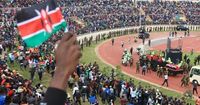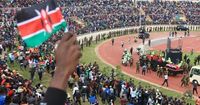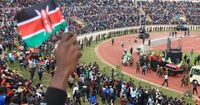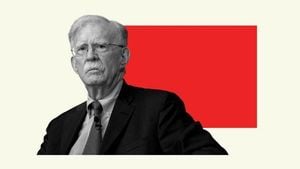Heavy security blanketed the western Kenyan city of Kisumu on Saturday, October 18, 2025, as thousands of mourners gathered for the final public viewing of former Prime Minister Raila Odinga’s body, marking an emotional crescendo in a week already marred by tragedy and unrest. Military officers, regular police, and even air surveillance teams were deployed to the city’s soccer stadium, where the crowd’s anticipation was palpable—and, for many, tinged with sorrow and anxiety. The heightened security followed a string of deadly incidents at earlier funeral events, casting a somber shadow over what was meant to be a celebration of a political titan’s life.
Odinga, who died on Wednesday, October 15, 2025, in India at the age of 80, was no stranger to the turbulence of Kenyan politics. Revered for his decades-long fight for democracy, he inspired fierce loyalty among his supporters and respect from leaders around the world—including former U.S. President Barack Obama, who once lauded Odinga’s commitment to democratic ideals. But as Kenya prepared to lay him to rest, the nation found itself reckoning with the very passions and divisions that Odinga had spent much of his life trying to bridge.
According to the Associated Press, the days leading up to Saturday’s viewing were anything but peaceful. On Thursday, October 16, during the first public viewing of Odinga’s body at the same soccer stadium, police fired live bullets and tear gas into the crowd after a confrontation broke out. The result was deadly: three people lost their lives. The violence did not end there. On Friday, October 17, at least two more people died in a stampede that erupted shortly after dignitaries left the venue of the state funeral service in Mamboleo, as reported by France 24. The stampede also left 163 others injured, a stark reminder of the risks that can arise when grief, devotion, and large crowds converge.
Despite the dangers, Odinga’s supporters—known for their resilience and passion—continued to turn out in droves. Many spent Friday night camped out at the stadium, determined to pay their last respects. By Saturday morning, the stadium was a sea of humanity, each person hoping for a final glimpse of the man who had shaped so much of Kenya’s recent history. The mood was a mix of reverence, exhaustion, and unease, with security forces keeping a watchful eye on the proceedings.
Odinga’s widow, Ida, made a heartfelt plea during the state funeral service, urging Kenyans to mourn peacefully. Her words echoed the sentiments of Odinga’s brother, Oburu, who addressed the crowd with a pointed reminder of the violence that had so often accompanied Odinga’s political journey. “Raila should not be teargassed in death. He has been teargassed enough when he was alive. Please let us not cause a situation where he is teargassed again,” Oburu implored, according to the Associated Press. The appeal was as much about honoring Odinga’s legacy as it was about preventing further tragedy.
For Kenya, Odinga’s passing marks the end of an era. Over the course of three decades, he ran for the presidency five times, coming agonizingly close but never quite clinching the top office. Still, his impact on the nation is undeniable. Odinga is widely credited with helping steer Kenya toward a vibrant multiparty democracy, often at great personal and political cost. His willingness to challenge entrenched power structures made him both a hero and a lightning rod, depending on whom you asked.
The outpouring of grief and respect for Odinga was evident in the honors accorded to him after his body arrived in Kenya on Thursday, October 16. On Friday morning, Odinga’s body lay in state at the Kenyan parliament—a privilege typically reserved only for presidents and former presidents. This gesture spoke volumes about the esteem in which he was held, even by those who had once stood in opposition to him.
Kenya’s current President, William Ruto, offered a eulogy that underscored the complexity of his relationship with Odinga. The two men had a history of both alliance and rivalry. Ruto campaigned for Odinga in the 2007 presidential election, a contest that was ultimately marred by violence and controversy. In subsequent elections, including the most recent one in 2022, they found themselves on opposite sides of the political divide. Yet, in 2025, after months of heated anti-government protests, Ruto and Odinga managed to broker a political agreement that brought opposition party members into Cabinet positions—a testament to Odinga’s enduring influence and pragmatism.
During the funeral events, Ruto described Odinga as “a patriot and selfless statesman who helped to steady the country,” as reported by the Associated Press. The words resonated with many Kenyans, who saw in Odinga a figure who, despite never ascending to the presidency, left an indelible mark on the nation’s political landscape.
The days of mourning have not been without their critics. Some have questioned the heavy-handed tactics of security forces, particularly in light of the deadly incidents at the funeral events. The use of live ammunition and tear gas against mourners sparked outrage among human rights groups and ordinary citizens alike, raising uncomfortable questions about the state’s approach to crowd control and the value placed on human life. At the same time, others have argued that the sheer scale of the crowds—and the intensity of emotion surrounding Odinga’s death—made some level of security intervention inevitable. Balancing the need for order with respect for the grieving process has proven to be a delicate and, at times, elusive goal.
The sense of loss extends beyond Kenya’s borders. Odinga’s reputation as a champion of democracy earned him admirers throughout Africa and around the world. His death has prompted tributes from international leaders and organizations, many of whom have highlighted his role in advancing political freedoms and civil rights.
As Kenya prepares for Odinga’s burial on Sunday, October 19, 2025, at his rural home in Bondo, western Kenya, the nation stands at a crossroads. The events of the past week have revealed both the depth of affection for Odinga and the persistent challenges facing Kenya’s democracy. For many, the hope is that his legacy will inspire a renewed commitment to peaceful political engagement and respect for the rule of law.
In the end, Odinga’s story is one of perseverance in the face of adversity, a life spent striving for a better Kenya. As thousands gather to bid him farewell, the question lingers: can the unity and purpose that defined his career outlast the divisions and tensions that have so often shaped the country’s politics? Only time will tell. But for now, Kenya mourns a giant, determined to honor his memory with dignity, even as it grapples with the pain of his loss.






